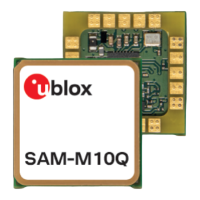
Do you have a question about the Ublox SAM-M10Q and is the answer not in the manual?
| Type | GNSS module |
|---|---|
| Tracking Sensitivity | -167 dBm |
| Horizontal Position Accuracy | 2.5 m |
| Velocity Accuracy | 0.05 m/s |
| Time Accuracy | 30 ns |
| Operating Temperature | -40°C to 85°C |
| Supply Voltage | 1.65 V to 3.6 V |
| Channels | 72 |
| Interfaces | UART, I2C |
| Operating Voltage | 1.8 V |
| GNSS Technology | GPS, GLONASS, Galileo, BeiDou |
Introduces the SAM-M10Q module, its features, and capabilities.
Describes the receiver's architecture and key functional blocks.
Details the pin configuration and function of the SAM-M10Q module.
Covers receiver configuration, reset, security, and basic operation.
Discusses GNSS augmentation, time bases, time pulse, and maintenance.
Explains communication interfaces (UART, I2C) and power save modes.
Covers protection levels, MGA, CloudLocate, and AssistNow features.
Explains Satellite-Based Augmentation System (SBAS) functionality and configuration.
Details Quasi-Zenith Satellite System (QZSS) Sub-meter Level Augmentation Service (SLAS).
Describes the Universal Asynchronous Receiver/Transmitter (UART) interface and its configuration.
Covers I2C interface, read access types, and write access limitations.
Details the functions of specific PIO pins like RESET_N, SAFEBOOT_N, TIMEPULSE, EXTINT, TX_READY.
Explains the continuous operation mode for signal acquisition and tracking.
Details Power Save Mode (PSM) operations including cyclic tracking, on/off mode, and external control.
Covers hardware and software backup modes for maintaining data during power loss.
Describes how the receiver maintains its internal local time.
Details supported GNSS time bases and UTC variants for time synchronization.
Explains navigation epochs, iTOW timestamps, and time validity.
Details UTC representation, leap seconds, and date ambiguity issues.
Describes how to measure the time of external interrupt pin events.
Details the parameters for configuring time pulse output frequency, length, and polarity.
Explains the receiver's Real-Time Clock (RTC) for maintaining time during power off.
Describes providing time and frequency assistance to the receiver.
Introduces the concept of protection level for GNSS output reliability.
Describes how protection level is published, interpreted, and its expected behavior.
Details AssistNow services (Online, Offline, Autonomous) and their requirements.
Explains how AssistNow Offline data is managed by the host system.
Describes the autonomous generation and use of satellite orbit data.
Explains how to request and collect satellite signal measurements for CloudLocate.
Covers VCC, V_IO, and V_BCKP pins, their roles, and supply requirements.
Discusses susceptibility to interference and mitigation strategies.
Focuses on RF design aspects, including the integrated antenna and RF front-end.
Discusses PCB layout considerations for integrating the GNSS module.
Covers essential safety precautions, including ESD sensitivity and general safety measures.
Describes packaging methods, MSL, and soldering procedures.
Lists key hardware and software changes for migrating from SAM-M8Q to SAM-M10Q.
Outlines key features for a typical SAM-M10Q integration design.
Lists related documentation and resources for further information.
Details the document's revision history and provides contact information.
